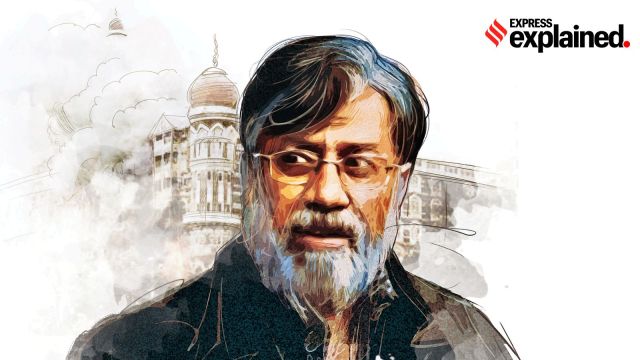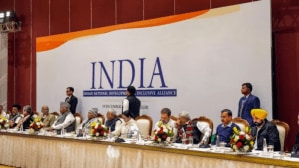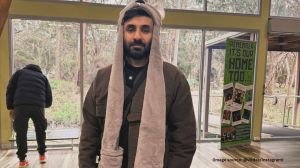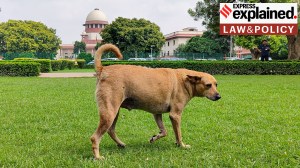26/11 attacks conspirator Tahawwur Rana has been extradited to India. What happens next?
Pakistani-origin Rana facilitated the travel to India of David Headley, the LeT operative who scouted targets for the 26/11 terror attacks. Rana’s arrival marks the culmination of a lengthy process to bring him to face justice in India
 Tahawwur Rana will likely be placed in judicial custody after he is produced before a special NIA court. (Illustration: Suvajit Dey)
Tahawwur Rana will likely be placed in judicial custody after he is produced before a special NIA court. (Illustration: Suvajit Dey)Tahawwur Hussain Rana, a key conspirator of the 26/11 terrorist attacks in Mumbai, arrived in Delhi on Thursday (April 10) following his extradition from the United States.
The arrival of Rana, who was arrested in Chicago in 2009, the year after the terror attacks in which 166 people were killed, marks the culmination of a prolonged legal process.
He will be prosecuted by the National Investigation Agency (NIA) on charges of terrorism. Other key 26/11 figures such as Hafiz Saeed, the founder of the Lashkar-e-Taiba, Major Iqbal, the shadowy ISI handler of the terrorists, and the terrorists’ trainer Sajid Majid alias Sajid Mir remain in Pakistan.
What happens now?
Tahawwur Rana will likely be placed in judicial custody after he is produced before a special NIA court. NIA and Intelligence Bureau officials will interrogate him to find missing pieces, if any, of the 26/11 jigsaw puzzle.
Although he has been previously questioned by the FBI, and prosecuted in the US for aiding the Lashkar-e-Taiba terrorist group and for his links to the Mumbai attacks, Indian authorities are expected to seek India-specific details relating to the conspiracy.
In 2011, the NIA had chargesheeted Rana, his associate and the attacks scout David Coleman Headley alias Daood Gilani, and seven others in absentia.
They were booked under Sections 16 (committing a terrorist act), 18 (conspiracy, attempting to commit, or advocating terrorist acts), and 20 (membership of a terror group) of the Unlawful Activities (Prevention) Act, 1967 (UAPA), and Sections 121 (waging war against the government), 121A (conspiracy for offences under 121), 302 (murder), 468 (forgery), and 471 (using forged documents) of the Indian Penal Code, 1860 (IPC) apart from criminal conspiracy.
A supplementary chargesheet is now expected to be filed, with the charges likely updated under the Bharatiya Nyaya Sanhita, 2023 (BNSS). Several of these charges carry the death penalty.
How fast Rana’s trial moves remains to be seen, however. India had secured the deportation of another 26/11 accused, Abu Jundal alias Zabiuddin Ansari, from Saudi Arabia in 2012. The trial against him still continues.
What was Tahawwur Rana’s role in the Mumbai attacks?
Submissions made by the FBI to US courts describe Rana, who is now 64, as a Pakistani native and a Canadian citizen who ran a Chicago-based immigration firm.
In 2006, Headley, who had been tasked by the LeT to scout Indian targets for terrorist attacks, planned to open an immigration office in Mumbai as a cover. He consulted Rana, who was his high school friend from Pakistan. According to the FBI, “Headley testified that he traveled to Chicago and advised Rana… of his assignment to scout potential targets in India.”
Rana approved and facilitated the setting up of a branch of his immigration services company, First World Immigration Services, in Mumbai. He also helped Headley obtain a visa, and got a company associate to prepare supporting documents.
The FBI’s evidence included transcripts of recorded conversations. In one conversation, Rana told Headley that the terrorists who attacked Mumbai should posthumously receive Pakistan’s highest military honours, the FBI claimed.
What did the NIA allege?
The NIA based its chargesheet on material evidence provided by the FBI and the interrogation of Headley.
Headley had been arrested by US authorities just before Rana, and he had pleaded guilty to his role in the 26/11 attacks. He was sentenced to a prison term in the US, one of his plea-bargain conditions being that he would not be extradited to India.
NIA investigators were granted access to Headley in the US.
According to the NIA’s chargesheet, in or about June 2006, before he made his first visit to India, Headley had travelled to Chicago and “discussed the whole conspiracy with Rana and took the assistance of Rana for using his immigration firm as a cover for executing the assignment entrusted by LeT”.
Rana helped Headley get a multi-entry Indian visa and set up the Mumbai branch of his company, which, however, did not process a single immigration case throughout its operation, the NIA said.
While in India, Headley conducted reconnaissance in Delhi, Mumbai, Jaipur, Pushkar, Goa, and Pune, scoping out vital installations, hotels, Jewish establishments, and Hindu sites.
Rana himself visited India along with his wife from November 13 to 21, 2008, just before the attack. They traveled to Hapur, Delhi, Agra, Cochin, Ahmedabad, Mumbai, and other locations.
The NIA claimed Rana was also involved in planning future attacks in India, and met LeT operative Abdur Rehman in Dubai ahead of the Mumbai attacks.
He also maintained contact with Major Iqbal, the alleged ISI handler of the terrorists and a key conspirator.
The cover provided by Rana helped Headley revisit India even after the attacks. The NIA alleged that Abdur Rehman and Ilyas Kashmiri, a Pakistani al-Qaeda operative who was killed in a US drone attack in North Waziristan in 2011, facilitated Headley’s visit to India in March 2009 to scout Jewish Chabad Houses for future strikes.
Rana remained in constant contact with Headley by phone during each of his visits to India — 32 times during the first visit, 23 times during the second, 40 times during the third, 37 times during the fifth, 33 times during the sixth, and 66 times during the eighth visit.
How did Rana’s extradition happen?
Following Rana’s arrest in 2009, the US District Court for the Northern District of Illinois prosecuted him on three counts: conspiring to provide material support to terrorism in India (Count 9); conspiracy to provide material support to terrorism in Denmark (Count 11); and providing material support to Lashkar-e-Taiba (Count 12).
The jury acquitted Rana on Count 9 but convicted him on Counts 11 and 12. On January 7, 2013, Rana was sentenced to 168 months in prison. On June 9, 2020, the court granted Rana’s motion for compassionate release and ordered him released immediately.
On June 10, 2020, a Magistrate Judge in the Central District of California, where Rana was serving his sentence, signed a provisional arrest warrant with a view to extraditing him to India to face charges there. This was done based on a December 2019 extradition request from India.
Rana opposed his extradition on the ground of “double jeopardy”, a procedural defence that seeks protection from being tried again on same or similar charges after an acquittal or conviction has already taken place.
But on May 16, 2023, the extradition Magistrate Judge rejected Rana’s arguments on the ground that the Indian charges had “elements” distinct from the charges under which Rana had been prosecuted, and eventually acquitted, by the Chicago court.
It was also held that “India had provided sufficient competent evidence to support the… finding of probable cause that Rana committed the charged crimes.”
Rana then petitioned the US District Court for the Central District of California for a writ of habeas corpus. This too was rejected on August 10, 2023. After this, Rana appealed the district court’s order in the Court of Appeals for the Ninth Circuit. This too was rejected.
Rana then filed a writ of certiorari in the US Supreme Court, which rejected on January 21 this year. His last ditch attempt to prevent his extradition through an emergency application to the Supreme Court there was also rejected.
Following these rejections, the US government approved his extradition to India.
Photos




- 01
- 02
- 03
- 04
- 05

































